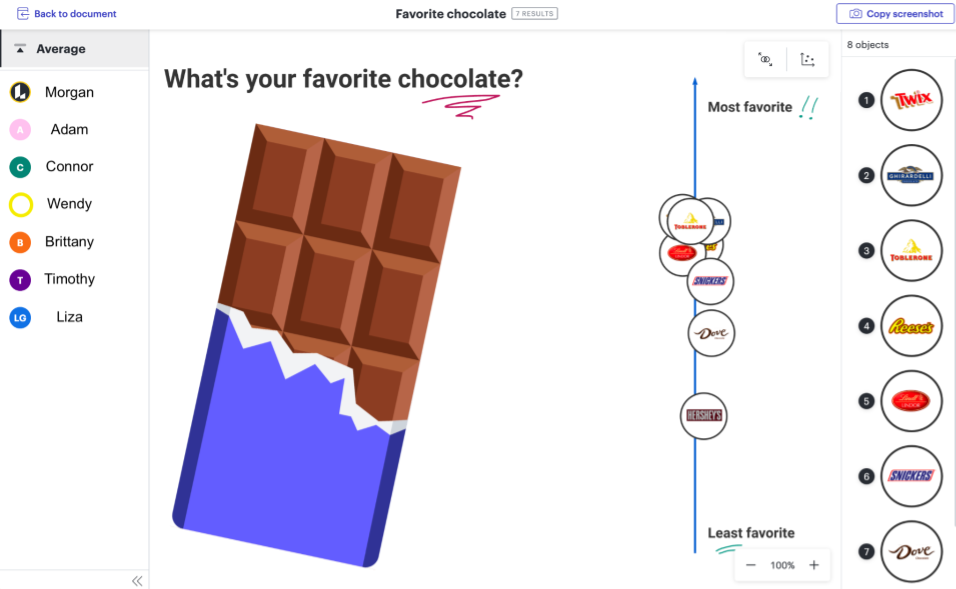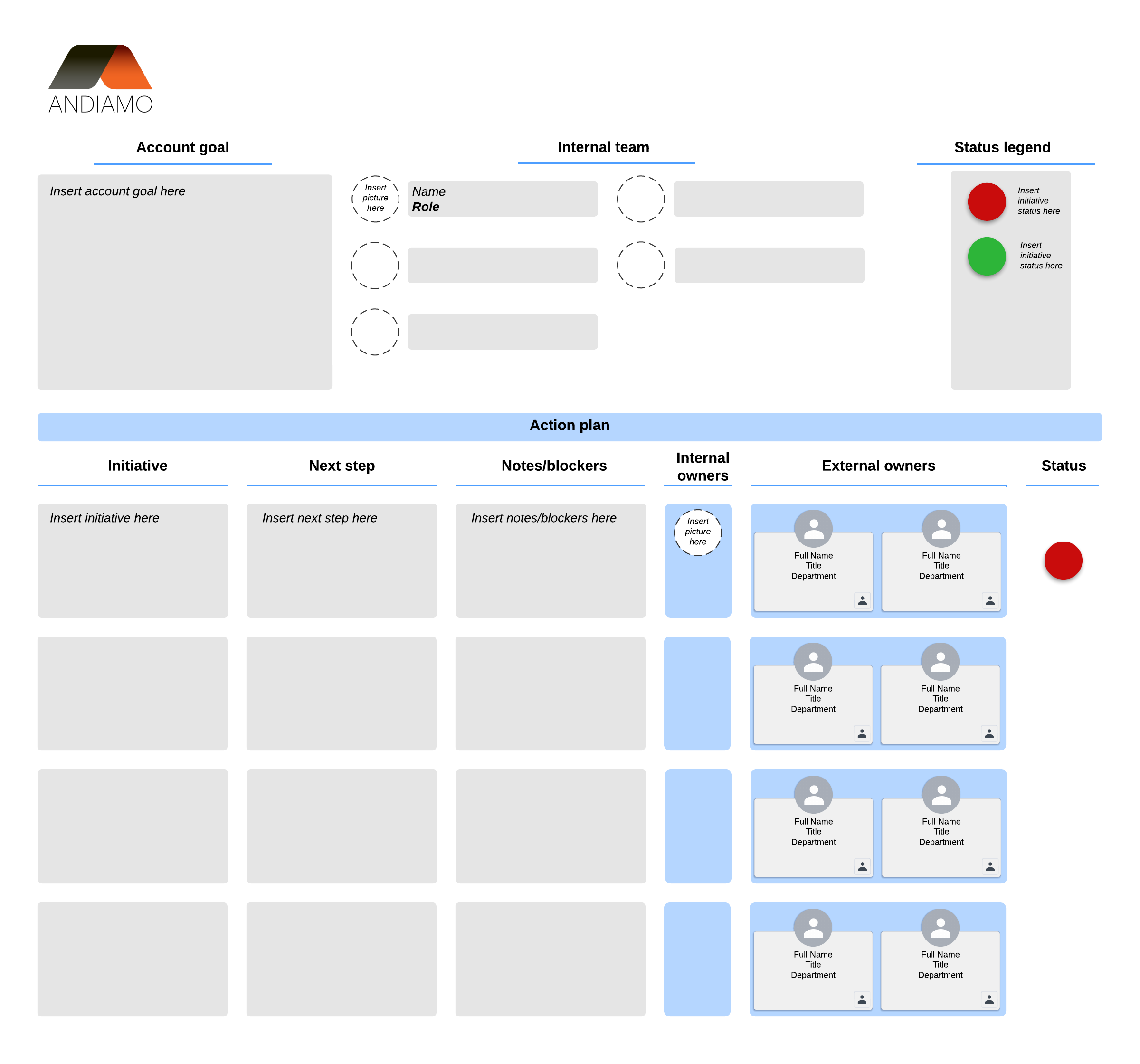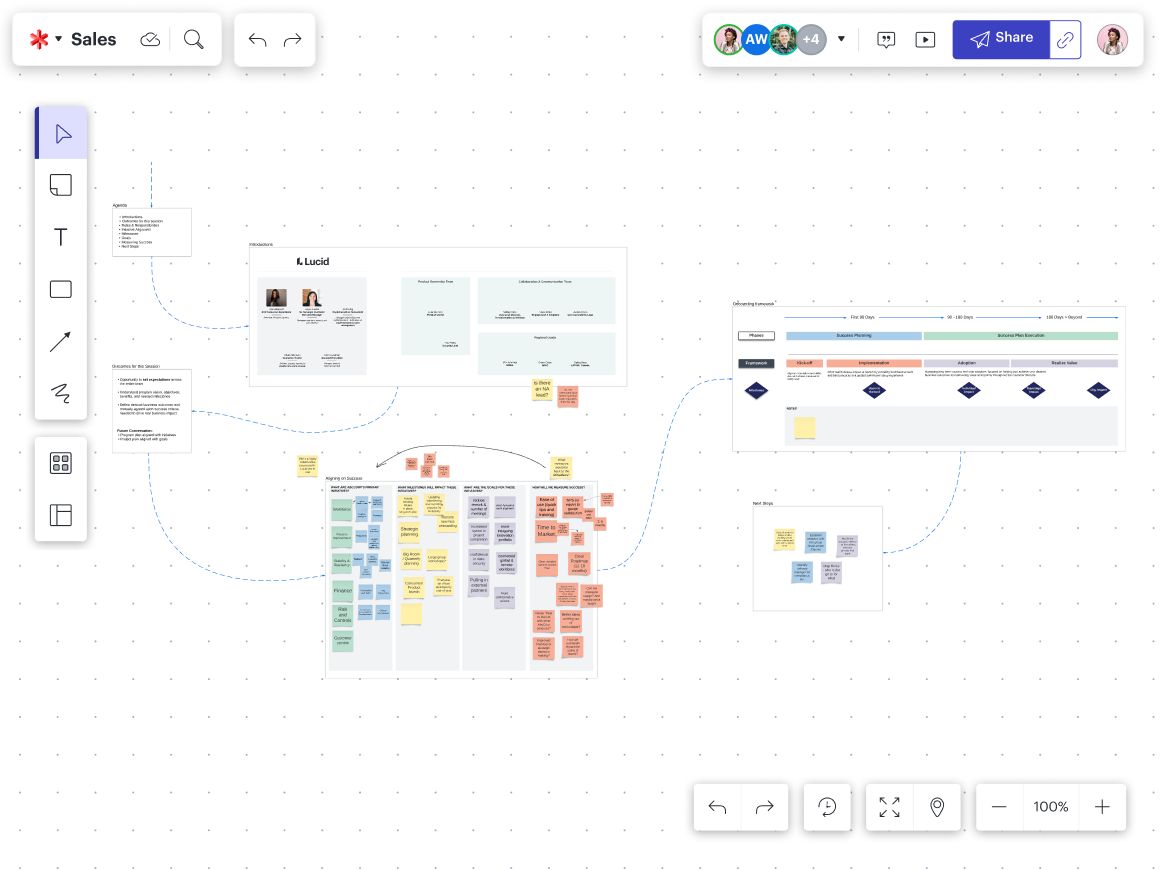
How Lucid’s sales teams use Lucid to close deals faster
Keith Tanaka
Reading time: about 7 min
Topics:
Today, business moves quickly. To keep up, sales teams are constantly working to find ways to collaborate and innovate.
Sales teams have to think hard about what makes business processes move faster. Visuals and collaboration are two key elements of that equation, which is why our sales teams at Lucid use Lucid’s own visual collaboration platform to stay on the cutting edge.
Our team uses Lucid to align internally, connect with customers, and uncover vital insights to close the deal. Lucid’s ability to support the entire sales cycle (from understanding complex account dynamics to visualizing the best path to sale) is vital to our success.
Here’s how our sales team uses the Lucid Suite to enhance our sales processes and close deals faster.
Discovery workshops
Understanding our prospects is the first step to a successful customer relationship. Sales teams need to invest time to understand their customers’ unique needs and challenges and genuinely connect with them to build collaborative relationships.
That’s why our customer-facing teams use Lucid to hold interactive and engaging discovery workshops with prospects and customers.

Here’s our process:
1. Preparation
First, we create a Lucidspark board before the customer call to guide the discussion. Using Frames to structure the board, we organize visual areas for introductions, customer pain points, timelines, and meeting notes. Then we arrange those Frames in a Path for presentation.
2. During the call
When we’re ready for the call, we share the board with all participants. Using the Guest Collaborator links, we can share the board with any non-customer participants. This gives everyone equal access to view and collaborate directly on the shared board.
Then we kick things off with a Visual Activity icebreaker to build engagement and warm everyone up. These interactive activities are a fun way to poll participants (e.g., What’s your favorite pizza topping?) and rank and categorize their answers for everyone to see and get to know each other. Simply browse the activity options to add one to your board.

3. Collaboration and contribution
With everyone warmed up, we can dive into the topic of our call. We encourage contributions from both reps and customers as we go, adding sticky notes to share ideas and organize content collaboratively. We also enable collaborator colors so each person has an assigned color so we can instantly see who has contributed each note.
The person leading the meeting enables Facilitator Tools to access additional features to help run a productive meeting. For example, we use tools like the laser pointer to draw attention to specific areas of the board as we present.
4. Wrap-up and documentation
At the end of the meeting, we make sure everyone is on the same page before closing by conducting a Visual Activity to prioritize the business needs we discussed. This is a quick way to organize ideas and leave with a list of our most important takeaways.
Then, we establish a desired timeline for next steps to set customer expectations upfront.
While the discovery call is over, the board remains an important part of our ongoing customer documentation for deal lifecycle management and alignment between the team and the customer. We use the board as a reference and iterative space that we can add to over time as we build our relationships.
Account planning
Understanding and synthesizing CRM data is a necessity for our sales teams. This data helps us uncover valuable insights so we can better understand our customers, personalize interactions, and optimize sales efforts.

That’s why our customer-facing teams use Lucid to build strategic account plans.
Here’s our process:
1. Standardized template creation
First, our leadership team designs a custom Lucidchart template for our account plans. All our reps use this template as the foundational framework for new deal account plans. Having this foundation ensures consistency across the organization and reduces repetitive tasks. The template makes it easy for our reps to plug and play, though they can also adapt it as needed.
2. Salesforce integration
Leveraging Lucid's bi-directional Salesforce integration, our teams can:
- Import account contacts directly into Lucidchart
- Automatically visualize the organizational structure and relationships within the account
- Sync contacts and assign opportunities, roles, and key relationships affecting deal progression
- Manage account plans in Salesforce, which are automatically updated in Lucidchart
3. Utilizing discovery board information
Using information from the original discovery board, our reps incorporate those insights into the new account plan. This includes adding account pain points and business needs directly to the plan.
As a result, vital account information is made easily accessible for team members in a central location.
4. Transition to Lucidspark
With Lucid’s universal canvas, our teams can seamlessly move their account plans into Lucidspark to drive more effective planning and ideation sessions. This flexibility is especially helpful as their accounts evolve.
From identifying new timelines and customer use cases to milestones and next steps, we consolidate all those insights into Lucidspark for further collaboration and planning.
Here’s our process:
1. Regular deal reviews
We conduct regular deal reviews using Lucid to increase collaboration and drive faster deal progression. By involving cross-functional teams in the review process, our reps benefit from the diverse perspectives, expertise, and valuable connections their colleagues have that add insight to the deal.
2. Using account maps and plans
To bring leadership up to speed fast, reps bring in account maps and account plans for greater clarity on deal background and status. These maps facilitate a shared understanding among all participants before the live review session. Account maps also aid executives in pinpointing areas to leverage their relationships for deal advancement.
This frees up time for reps to focus discussions during the review on addressing concerns, identifying milestones, and gaining executive support for forward solutions.
3. Outreach and follow-up planning
From there, teams can develop outreach strategies and follow-up timelines post-review. Lucid makes it easy to tag participants, comment on specific areas of the board, and organize priorities and timelines in one visual space.
Identifying these next steps and action items helps us maintain the deal's momentum and freshness over time.

4. Continued account plan development
Our account document then serves as a reference for ongoing account plan development. With this single source of truth, our sales reps can make easy adjustments and adaptations during subsequent stages of the deal based on review insights and discussions.
Why Lucid sales teams love Lucid
Lucid allows us to move deals forward faster—together. On Lucid’s powerful platform, we’re able to:
- Conquer complex sales to close bigger deals faster: Lucid’s comprehensive integrations make it easy to import and visualize data automatically. This enables effective cross-functional collaboration with team members and leaders, promoting better insights and shared expertise that smooths the path to sale.
- Engage customers from day one: Lucid is powerful but easy to use and easy to share. This allows us to onboard and connect with our customers in genuine ways right from the start.
- Build strategic account maps and account plans. Great deals are built on great information. Lucid helps our teams gather, organize, and share key insights in dynamic and digestible account maps and plans.
- Streamline deal reviews and QBRs: With everything organized in one place, deal reviews and QBRs are easier than ever. Sales leaders can quickly get up to speed on current deal status and collaborate with reps to identify opportunities and brainstorm solutions to potential roadblocks.
- Document key sales processes in one accessible place. Lucid acts as a single source of truth, helping our reps stay on top of their deals and preventing critical mistakes due to missed information or things falling through the cracks.
- Build a shared space to connect: With Lucid facilitator tools, data linking, and more, our teams can connect, collaborate, and build alignment from one shared place.
With Lucid’s dynamic Visual Activities, customizable template library, and robust sharing and integration features, sales teams like ours can build stronger customer relationships, take more strategic action, and unlock faster paths to sale. These traits make Lucid the ideal solution for sales teams.

Try Lucid for yourself
Curious about how Lucid could fit into your sales team’s workflow?
Request a demoAbout the author

Keith leads strategic accounts at Lucid with his passion for crafting collaboration-based solutions to solve enterprise challenges. Previously, Keith successfully helped build and scale sales organizations at multiple companies, including Dell EMC and SaltStack. He holds a B.S. in marketing from Brigham Young University.
About Lucid
Lucid Software is the leader in visual collaboration and work acceleration, helping teams see and build the future by turning ideas into reality. Its products include the Lucid Visual Collaboration Suite (Lucidchart and Lucidspark) and airfocus. The Lucid Visual Collaboration Suite, combined with powerful accelerators for business agility, cloud, and process transformation, empowers organizations to streamline work, foster alignment, and drive business transformation at scale. airfocus, an AI-powered product management and roadmapping platform, extends these capabilities by helping teams prioritize work, define product strategy, and align execution with business goals. The most used work acceleration platform by the Fortune 500, Lucid's solutions are trusted by more than 100 million users across enterprises worldwide, including Google, GE, and NBC Universal. Lucid partners with leaders such as Google, Atlassian, and Microsoft, and has received numerous awards for its products, growth, and workplace culture.
Related articles
15 hacks for making your meetings more productive with Lucid
Here are some simple hacks you can do in Lucid to save time so you can collaborate more efficiently with your team during meetings.
New intelligent features: Collaborative AI, ChatGPT plugin, and AI Prompt Flow
Use Collaborative AI and AI Prompt Flow to improve efficiency and get more done. Use the Lucid ChatGPT plugin to auto-generate diagrams.
The complete toolkit for asynchronous collaboration
Use the templates in this toolkit to collaborate asynchronously with your team—anytime, anywhere.
How to improve sales and marketing collaboration
Learn how sales and marketing teams can strengthen collaboration and alignment and ultimately increase company revenue.
